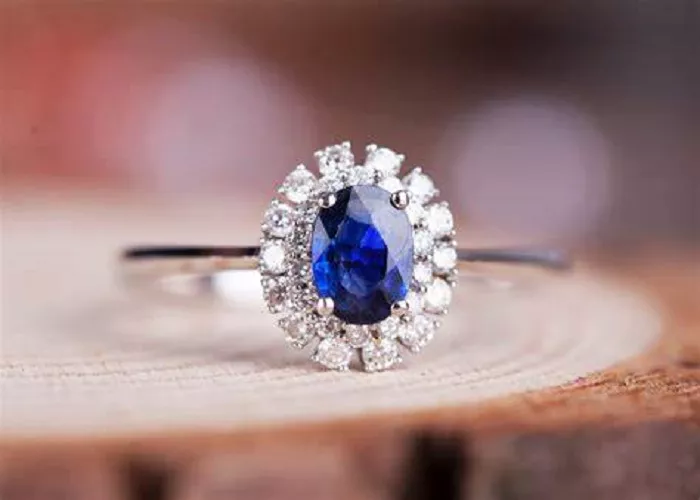Natural blue sapphire engagement rings are a stunning and meaningful choice for couples who want something unique and elegant. Sapphires are known for their deep blue color, durability, and rich history. Unlike diamonds, which are more common in engagement rings, sapphires offer a distinctive and luxurious look.
In this article, we will explore what makes natural blue sapphires special, the history and meaning behind sapphire engagement rings, how sapphires are graded and valued, different ring settings and designs, how to care for a sapphire engagement ring, and why a sapphire ring might be the perfect choice for you.
By the end, you will have a clear understanding of why natural blue sapphire rings are a beautiful and meaningful option for an engagement ring.
What Are Natural Blue Sapphires?
A Precious Gemstone
Sapphires belong to the corundum mineral family, the same family as rubies. While rubies are red, sapphires come in many colors, but the most famous and sought-after is blue.
How Are They Formed?
Natural blue sapphires are formed deep within the Earth under extreme heat and pressure. They are mined from rocks or riverbeds in countries like Sri Lanka, Madagascar, Australia, and Myanmar (Burma).
What Gives Them Their Blue Color?
The blue color comes from trace elements of titanium and iron in the crystal structure. The more titanium and iron, the deeper the blue. Some sapphires also have slight color variations, making each stone unique.
Durability
Sapphires are extremely hard, scoring 9 on the Mohs hardness scale (diamonds are 10). This makes them perfect for everyday wear, as they resist scratches and damage.
The History and Meaning of Sapphire Engagement Rings
Royal Connections
Sapphires have long been associated with royalty and nobility. One of the most famous sapphire engagement rings belonged to Princess Diana and is now worn by Kate Middleton, Duchess of Cambridge. This royal connection has made sapphires even more popular.
Symbolism
Sapphires have been linked to wisdom and honesty. Their deep blue color represents trust and commitment. Ancient cultures believed sapphires guarded against harm.
A Unique Alternative to Diamonds
While diamonds are traditional, sapphire engagement rings offer a bold and personal touch. Many couples choose sapphires to stand out and express individuality.
How Are Sapphires Graded and Valued?
When buying a natural blue sapphire engagement ring, it’s important to understand how sapphires are graded. The main factors are color, clarity, cut, carat weight, and origin.
Color
The hue is the primary color, which is blue with possible hints of green or purple. Saturation refers to how intense the color is, with vivid blue being the most valuable. Tone describes how light or dark the color is, with medium to dark tones being preferred. The most prized sapphires have a rich, velvety blue color often called “cornflower blue” or “royal blue.”
Clarity
Sapphires often have small inclusions, which are natural imperfections. Some inclusions are acceptable, but too many can affect the stone’s brilliance. Eye-clean sapphires, which have no visible flaws to the naked eye, are the best choice.
Cut
A good cut enhances the sapphire’s color and sparkle. Common cuts for sapphires include oval, round, cushion, emerald, and pear.
Carat Weight
Larger sapphires are rarer and more expensive. However, color and quality matter more than size.
Origin
Some locations produce the finest sapphires. Kashmir in India is known for the most vibrant blue sapphires, though they are very rare and expensive. Burma (Myanmar) produces high-quality deep blue sapphires. Sri Lanka (Ceylon) offers lighter, brighter blue sapphires. Madagascar is a newer source with beautiful blue stones.
Popular Ring Settings for Blue Sapphire Engagement Rings
The setting you choose can dramatically change the look of your ring. Here are some popular options.
Solitaire Setting
A single sapphire on a simple band is classic and elegant. It works well with white gold, yellow gold, or platinum.
Halo Setting
The sapphire is surrounded by small diamonds, making it look bigger and more sparkly. This adds extra brilliance to the ring.
Three-Stone Setting
This features a center sapphire with two side diamonds, symbolizing past, present, and future. It’s a meaningful and balanced design.
Vintage or Antique Style
These rings have intricate details like milgrain edges and filigree work. They often feature sapphires with diamond accents.
East-West Setting
The sapphire is set horizontally for a modern look. This is unique and eye-catching.
Bezel Setting
The sapphire is secured with a metal rim, which is great for active lifestyles. This provides extra protection for the stone.
How to Care for a Sapphire Engagement Ring
Sapphires are durable, but they still need proper care to stay beautiful.
Cleaning
Use warm soapy water and a soft brush. Avoid harsh chemicals like bleach and chlorine. Ultrasonic cleaners are usually safe, but check with a jeweler first.
Storage
Keep your ring in a soft pouch or separate compartment to avoid scratches.
Regular Check-Ups
Have a jeweler inspect the setting every year to ensure the stone is secure.
Why Choose a Natural Blue Sapphire Engagement Ring?
Unique and Personal
A sapphire ring stands out from traditional diamond rings. It can be customized with different settings and metal choices.
Durable and Long-Lasting
Sapphires are hard enough for daily wear and won’t scratch or chip easily.
Rich in Meaning
Sapphires represent loyalty, wisdom, and eternal love. They have a royal and historical significance.
Ethical and Sustainable Options
Many sapphires are ethically mined. Lab-grown sapphires are also available for eco-conscious buyers.
Conclusion
A natural blue sapphire engagement ring is a breathtaking and meaningful choice. With their deep blue color, durability, and royal history, sapphires make a perfect symbol of love and commitment. Whether you prefer a classic solitaire, a vintage-inspired design, or a modern halo setting, there’s a sapphire ring to match every style.
If you want an engagement ring that’s both timeless and unique, a natural blue sapphire could be the perfect gemstone for you.
Related Topics:
- Where Do Kentucky Blue Sapphires Come From?
- Where is Sapphire Blue Hole?
- Does Sapphire Have Any Special Properties?


